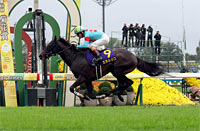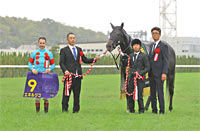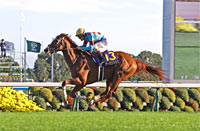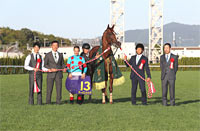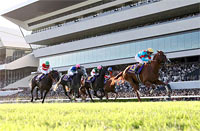Kikuka Sho (Japanese St. Leger) (G1) - Data Analysis
Final leg of the Triple Crown to be held at Hanshin Racecourse this year
The Kikuka Sho (Japanese St. Leger), which is the final leg of the Triple Crown, will be held on the 3,000m turf course at Hanshin Racecourse this year as Kyoto Racecourse is undergoing maintenance work. Which runner is likely to triumph in this race in which a “strong horse” is said to dominate? Let’s now look for some trends in the race based on results over the last 10 years and data for 3,000m turf races held at Hanshin Racecourse.
Course puts runners starting in the middle brackets at a slight disadvantage
A total of 10 races (all Hanshin Daishoten) have been held on the 3,000m turf course at Hanshin Racecourse over the last 10 years. Looking at performances by runners in those races in terms of bracket number, we find that runners starting in or near the middle brackets had low success ratios. Among the Top 3 finishers, the bulk of the runners that started in Brackets 1 or 2 led the field and avoided a distance disadvantage throughout the race, while many runners that started in Brackets 6, 7, or 8 advanced their position from the back of the field throughout the race. In other words, we should look at running style and bracket number to identify leading contenders. [Table 1]
[Table 1] Performance on 3,000m turf course at Hanshin Racecourse by bracket number (2012 to June 2021)
| Bracket number |
Performance
[1st-2nd-3rd-4th or lower] |
Win ratio |
Top 2 ratio |
Top 3 ratio |
| 1 |
2-0-2-6 |
20.0% |
20.0% |
40.0% |
| 2 |
0-1-2-7 |
0% |
10.0% |
30.0% |
| 3 |
0-1-1-8 |
0% |
10.0% |
20.0% |
| 4 |
0-1-2-8 |
0% |
9.1% |
27.3% |
| 5 |
1-0-1-10 |
8.3% |
8.3% |
16.7% |
| 6 |
1-4-1-9 |
6.7% |
33.3% |
40.0% |
| 7 |
2-1-1-14 |
11.1% |
16.7% |
22.2% |
| 8 |
4-2-0-14 |
20.0% |
30.0% |
30.0% |
Watch number of previous wins
Looking at performances by runners in the Kikuka Sho (Japanese St. Leger) over the last 10 years in terms of the number of previous wins, we observe that all three runners with 5 or more previous wins triumphed, while three of the 13 runners with 4 previous wins also secured a victory. The bulk of the runners that entered the race had 3 or 2 previous wins. While these runners collectively delivered only four winners, which was low, they produced nine runners-up and nine third-place finishers. Among the runners with 2 or 3 previous wins, we should focus our attention on those that have contested a JRA graded race last time out and finished either 2nd or 3rd in that race. Runners in this group achieved performance of [4-7-3-20] (Top 3 ratio of 41.2%), and had high success ratios. However, we should also keep in mind that the four runners with 2 or 3 previous wins that had won a graded race last time out, were all beaten to 6th or lower. Finally, runners with 1 previous win only produced one runner-up, so runners with this profile are likely to struggle. [Table 2]
[Table 2] Performance by number of previous wins (last 10 years)
| Number of previous wins |
Performance
[1st-2nd-3rd-4th or lower] |
Win ratio |
Top 2 ratio |
Top 3 ratio |
| 5 or more |
3-0-0-0 |
100% |
100% |
100% |
| 4 |
3-0-1-9 |
23.1% |
23.1% |
30.8% |
| 3 |
1-4-7-76 |
1.1% |
5.7% |
13.6% |
| 2 |
3-5-2-55 |
4.6% |
12.3% |
15.4% |
| 1 |
0-1-0-10 |
0% |
9.1% |
9.1% |
Focus on runners coming from trial races
While the Kikuka Sho (Japanese St. Leger) has been won by runners coming from allowance races in the past, only runners that had previously contested a graded race have notched the win in the last 10 years. Runners coming from an allowance race have produced runners-up and third-place finishers, but their success ratios have been low, making it difficult to take them into consideration when planning bet formations. Runners that had previously contested a G2 race exhibited strong performance. Within this group, runners coming from the Kobe Shimbun Hai (Japanese St. Leger Trial) delivered performance of [8-5-4-49], and occupied over half of the Top 3 finishers. Incidentally, runners coming from the Kobe Shimbun Hai (Japanese St. Leger Trial) have consistently finished in the Top 2 since 2010. [Table 3]
[Table 3] Performance by previous race (last 10 years)
| Previous race |
Performance
[1st-2nd-3rd-4th or lower] |
Win ratio |
Top 2 ratio |
Top 3 ratio |
| G1 |
0-0-0-1 |
0% |
0% |
0% |
| G2 |
9-9-6-98 |
7.4% |
14.8% |
19.7% |
| G3 |
1-0-0-4 |
20.0% |
20.0% |
20.0% |
| Open-class race |
0-0-0-1 |
0% |
0% |
0% |
| Allowance race |
0-1-4-45 |
0% |
2.0% |
10.0% |
| NAR race |
0-0-0-1 |
0% |
0% |
0% |
Target runners that have finished in the Top 2 of the Kobe Shimbun Hai (Japanese St. Leger Trial)
Based on the information in the previous paragraph, we now look at runners coming from the Kobe Shimbun Hai (Japanese St. Leger Trial), and note that those that had finished in the Top 2 of that race delivered the strongest performance. As shown in the table below, the Top 2 finishers in the Kobe Shimbun Hai (Japanese St. Leger Trial) delivered performance of [6-1-2-1] in the Kikuka Sho (Japanese St. Leger) over the last 10 years, resulting in a Top 3 ratio of 90.0%. In other words, we should not overlook the Top 2 finishers in the Kobe Shimbun Hai (Japanese St. Leger Trial). [Table 4]
[Table 4] Kikuka Sho (Japanese St. Leger) performance by Top 2 finishers in the Kobe Shimbun Hai (Japanese St. Leger Trial) (last 10 years)
| Year |
Top 2 finishers in Kobe Shimbun Hai
(Japanese St. Leger Trial) |
Finish in Kikuka Sho
(Japanese St. Leger) |
| 2011 |
Orfevre (1st) |
1st |
| 2012 |
Gold Ship (1st) |
1st |
| 2013 |
Epiphaneia (1st) |
1st |
| 2014 |
One and Only (1st) |
9th |
| 2015 |
Lia Fail (1st) |
3rd |
| 2016 |
Satono Diamond (1st) |
1st |
| 2017 |
Kiseki (2nd) |
1st |
| 2018 |
Etario (2nd) |
2nd |
| 2019 |
Velox (2nd) |
3rd |
| 2020 |
Contrail (1st) |
1st |
Seek out the winner!
Runners that have avoided major defeats and achieved consecutive victories are win contenders
Only three of the last 10 winners had been beaten to 6th or lower prior to entering the Kikuka Sho (Japanese St. Leger), and two of these had only experienced such a defeat once. The last five winners had not previously been beaten to 6th or lower. In addition, nine of the last 10 winners had previously achieved consecutive victories. The only winner without such experience was World Premiere, but that runner had not been beaten to 4th or lower since his debut race. Based on the trends above, we should consider runners that have avoided major defeats and achieved consecutive victories as win contenders. [Table 5]
[Table 5] Winners’ finishes in 6th place or lower, and experience of consecutive victories (last 10 years)
| Year |
Winners |
Finishes in 6th place or lower |
Experience of consecutive victories |
| 2011 |
Orfevre |
1 |
Yes |
| 2012 |
Gold Ship |
0 |
Yes |
| 2013 |
Epiphaneia |
0 |
Yes |
| 2014 |
Toho Jackal |
2 |
Yes |
| 2015 |
Kitasan Black |
1 |
Yes |
| 2016 |
Satono Diamond |
0 |
Yes |
| 2017 |
Kiseki |
0 |
Yes |
| 2018 |
Fierement |
0 |
Yes |
| 2019 |
World Premiere |
0 |
No |
| 2020 |
Contrail |
0 |
Yes |
(Yodohito Himezono)
|















